Circularity in the governance of the Built Environment: Political instruments and actors
instrumentos políticos e atores
DOI:
https://doi.org/10.46421/entac.v20i1.6095Keywords:
Governance in the built environment, Political instruments, Circular economy, Actors involvement, Circular built environmentAbstract
In the context of Civil Construction, an industry generating significant environmental impacts, there is a growing incentive for extending the lifespan of materials and buildings, employing concepts of Circular Economy for this purpose. Seeking to understand the landscape of circularity implementation in Built Environment governance and the participation of various actors throughout the process, this study aimed to identify best practices in implementation and progress. The analysis assessed political instruments and the involvement of observed actors, categorizing them according to methodologies developed by the European Union's Eco-innovation Observatory, which are closely aligned with the objectives of Circular Economy. The findings demonstrate that adaptations in current governance practices could: bring the sector closer to circularity, induce restructuring of existing social relations, as well as enhance new business models, all in accordance with recent observed environmental challenges.
References
ZIMMANN, R. et al. The circular economy in the built environment. Arup: London, UK, 2016.
MACARTHUR, Ellen. Rumo à economia circular: O racional de negócio para acelerar a transição. Ellen MacArthur Foundation, 2015.
SENAI. Departamento Regional do Paraná. Rotas Estratégicas para o Futuro da Indústria Paranaense 2031 – Curitiba: Fiep/PR. 2019.
DORANOVA, Asel et al. Policies and practices for eco-innovation up-take and circular economy transition. European Commission & Eco-Innovation Observatory (EC&EIO): Brussels, Belgium, 2016.
SENAI. Departamento Regional do Paraná Elementos de Economia Circular – Curitiba: Fiep/PR. 2019.
MUNARO, Mayara Regina; TAVARES, Sérgio Fernando. Analysis of Brazilian public policies related to the implementation of circular economy in civil construction. Ambiente Construído, v. 22, p. 129-142, 2022.
BAO, Zhikang et al. Procurement innovation for a circular economy of construction and demolition waste: Lessons learnt from Suzhou, China. Waste Management, v. 99, p. 12-21, 2019.
MUNARO, Mayara Regina; TAVARES, Sérgio Fernando; BRAGANÇA, Luís. Towards circular and more sustainable buildings: A systematic literature review on the circular economy in the built environment. Journal of Cleaner Production, v. 260, p. 121134, 2020.
BICKET, M. et al. Scoping study to identify potential circular economy actions, priority sectors, material flows and value chains. 2014.
VAN BUEREN, B. J. A.; LEENDERS, M. A. A. M.; NORDLING, T. E. M. Case Study: Taiwan’s pathway into a circular future for buildings. In: IOP Conference Series: Earth and Environmental Science. IOP Publishing, 2019. p. 012060.
CAMPBELL-JOHNSTON, Kieran et al. City level circular transitions: Barriers and limits in Amsterdam, Utrecht and The Hague. Journal of cleaner production, v. 235, p. 1232-1239, 2019.
FRATINI, Chiara Farné; GEORG, Susse; JØRGENSEN, Michael Søgaard. Exploring circular economy imaginaries in European cities: A research agenda for the governance of urban sustainability transitions. Journal of cleaner production, v. 228, p. 974-989, 2019.
GIORGI, Serena; LAVAGNA, Monica; CAMPIOLI, Andrea. Circular economy and regeneration of building stock in the Italian context: Policies, partnership and tools. In: IOP Conference Series: Earth and Environmental Science. IOP Publishing, 2019. p. 012065.
GÓRECKI, Jarosław et al. How to convince players in construction market? Strategies for effective implementation of circular economy in construction sector. Cogent engineering, v. 6, n. 1, p. 1690760, 2019.
LEMAITRE, C. et al. Fostering the integration of circular economy aspects into the construction and real estate industry. In: IOP Conference Series: Earth and Environmental Science. IOP Publishing, 2019. p. 012021.
MILIOS, Leonidas. Advancing to a Circular Economy: three essential ingredients for a comprehensive policy mix. Sustainability science, v. 13, n. 3, p. 861-878, 2018.
NAZARETH, August P. How close is the built environment to achieving circularity?. In: IOP Conference Series: Earth and Environmental Science. IOP Publishing, 2019. p. 012070.
PLOEGER, Hendrik et al. Circular economy and real estate: the legal (im) possibilities of operational lease. Facilities, v. 37, n. 9/10, p. 653-668, 2019.
PRENDEVILLE, Sharon; CHERIM, Emma; BOCKEN, Nancy. Circular cities: Mapping six cities in transition. Environmental innovation and societal transitions, v. 26, p. 171-194, 2018.
RAHLA, K. M.; BRAGANÇA, L.; MATEUS, Ricardo. Obstacles and barriers for measuring building’s circularity. In: IOP Conference Series: Earth and Environmental Science. IOP Publishing, 2019. p. 012058.
VALENZUELA, Luis M.; TISI, Rodrigo; HELLE, LUCAS. High density architecture as local factory of circular economy. International Journal of Sustainable Development and Planning, v. 13, n. 7, p. 985-996, 2018.
WILLIAMS, Joanna. Circular cities: Challenges to implementing looping actions. Sustainability, v. 11, n. 2, p. 423, 2019.
IDEIA CIRCULAR e UCCI. Manual de Economia Circular para Cidades Ibero-americanas. São Paulo, 2022.
GUARNIERI, Patricia; CERQUEIRA-STREIT, Jorge A.; BATISTA, Luciano C. Reverse logistics and the sectoral agreement of packaging industry in Brazil towards a transition to circular economy. Resources, conservation and recycling, v. 153, p. 104541, 2020.
EUROPEIA, Comissão. Fechar o ciclo–plano de ação da UE para a economia circular. Official Journal of the European Union, COM (2015), v. 24, 2015.
CAPELLE, Teodora et al. Testing BAMB results through prototyping and pilot projects: D14-4 pilots built+ feedback report. 2019.
EIO. 2013. “Europe in Transition: Paving the Way to a Green Economy through Eco-Innovation. Annual Report 2012. Financed by the European Commission, DG Environment.” Brussels: Eco- Innovation Observatory.

